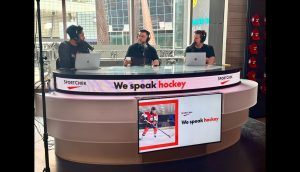BBM Canada’s annual Staying Tuned conference, this year dubbed ‘Research for a Diverse World,’ drew hundreds of media, advertising and measurement professionals to a Toronto venue yesterday. Topics covered included viewers taking control, advertising to cultural consumers in Canada, lifestyles analysis based on census data and threats to the quality of data gleaned by online panels.
In one of the morning’s highlights, Robert Hutton, EVP/GM of Toronto-based Pollara Strategic Insights, described his company’s effort ‘to find out what exactly is behind that buzz, and if there’s any substance that’s of interest to broadcasters and advertisers.’
In a presentation called ‘The Social Media Sandbox,’ Hutton reviewed attitudes of corporate executives and consumers toward social media, as reflected in the results of a survey of 2,265 Canadians 18+ in September 2007 (which Pollara executed in conjunction with Veritas Communications) and another poll of 1,181 Canadians last month.
According to the data, almost half of Canadians had registered with a social media site, with about 64% participating in some form of user-generated content. ‘We noted a high level of ‘don’t know’ responses,’ said Hutton. ‘That is based, I think, on the dichotomy between awareness and understanding among social media users. Even active users had a lack of understanding despite the high level of awareness.’
The research found that 28% of corporate respondents said they are more aware of social media tools than their customers are, and more than two in five have profiles on sites like MySpace and Facebook. ‘There’s a split personality here,’ Hutton explained, pointing out that corporate execs want their employees and colleagues to participate in social media, but still view them as time-wasters.
While corporate execs expressed that social media is important and gaining momentum, they also said it will not replace traditional media. Only 12% said they would spend more on social media this year; 39% will spend about the same amount as last year; and 32% said they don’t spend anything on it and don’t intend to in the future. For those who do plan to spend more, 29% said they would cut back on TV advertising in favour of social media, while 31% said they would just increase their overall marketing budget.
Of consumers polled, 52% said social media is important in maintaining and nurturing relationships – connecting friends to friends and like-minded groups. About 59% consider social media to be very important or somewhat important in learning about new products, and about eight in 10 use social media to investigate products in general.
Hutton said the numbers show that social media is part of the brand discussion, and people are talking about them, interacting with them and sharing info about them. Still, 53% said brands don’t belong in social media (consistent among men, women and the 18-34 demo); 29% believe brand reps should monitor what’s being said about them but intervene with caution; 50% believe social media sites are already becoming too commercialized; and 28% said they will search out other options if a social media site becomes too commercialized.
‘What people learn in social media, they’re taking outside of the arena and going to television, the press and other unbiased sources of information to confirm and get unbiased information,’ Hutton concluded. ‘Influence by interaction from peer to peer? This is very interesting. There don’t appear to be opinion leaders, super-consumers or influencers in social media. Our results suggest that the influence of social media is diffuse, spread among a large group of people, and the true influencers are friends and family – the people they’re closest to and trust.’
In another presentation titled ‘Engagement, Emotions and the Power of Radio,’ Jim Peacock, president of Laurel, Maryland-based Peacock Research, discussed the latest findings of the Radio Ad Lab (www.radioadlab.org), an industry-funded organization conducting research projects about how radio advertising affects the mind of the consumer (most of which are now available for free online).
Peacock said the Radio Ad Lab’s latest study, conducted by Gallup & Robinson, found – by measuring smiles, frowns and other physiological responses such as skin conductance – that radio ads have an emotional impact on consumers that is equal to that of television ads. The conclusions were drawn after exposing 160 consumers in a living room setting to 16 real ad campaigns in both media (within a programming context) and measuring their positive and negative emotional lift or drop.
‘On average, when the radio ads came on, there was about 17% positive emotional lift, and with TV ads it was about the same,’ said Peacock. ‘The radio and the TV averages were effectively the same. We’ve also compared younger people to older people and men to women. That finding is the same for 18-34-year-olds, for 35-54s, for men and for women. There was also no difference in unaided recall between the radio ads and the TV ads. We are digging into this question of advertiser benefit in terms of branding points within the ads. That’s a follow-up analysis we’re releasing shortly.’
Another direction for Radio Ad Lab’s research is minute-by-minute analysis using these measurement techniques with the goal of helping advertisers build better radio ad experiences. In wrapping up his presentation, Peacock urged the crowd to consider that ‘people don’t put a lot of time and effort into radio ad creation. Just think of how those radio ads could have been if they’d spent more time on them.’
Bill Siegel, chairman and founder of Toronto-based Longwoods International, tackled the question of measurement beyond television and radio in a presentation called ‘Measuring Campaign ROI in a Multimedia World.’ In a world where fragmentation of audiences continues and CEOs want to know the amount of sales generated from their $50-million ad budgets, Siegel said it’s more important than ever to address the silo problem and end the linear thinking that still happens in what’s now a non-linear media landscape.
‘It’s a bit of a mess out there in terms of measurement,’ Siegel told the audience. Part of the solution, he added, may be to stop measuring what you bought and start measuring what you got. Longwoods’ MediaMnemonics attempts to measure the impact of holistic marketing on the brain. ‘There are two variables,’ he explained. ‘You want to look at sales, and you want to look at advertising expenditures – and the recall of the ad exposures.’























